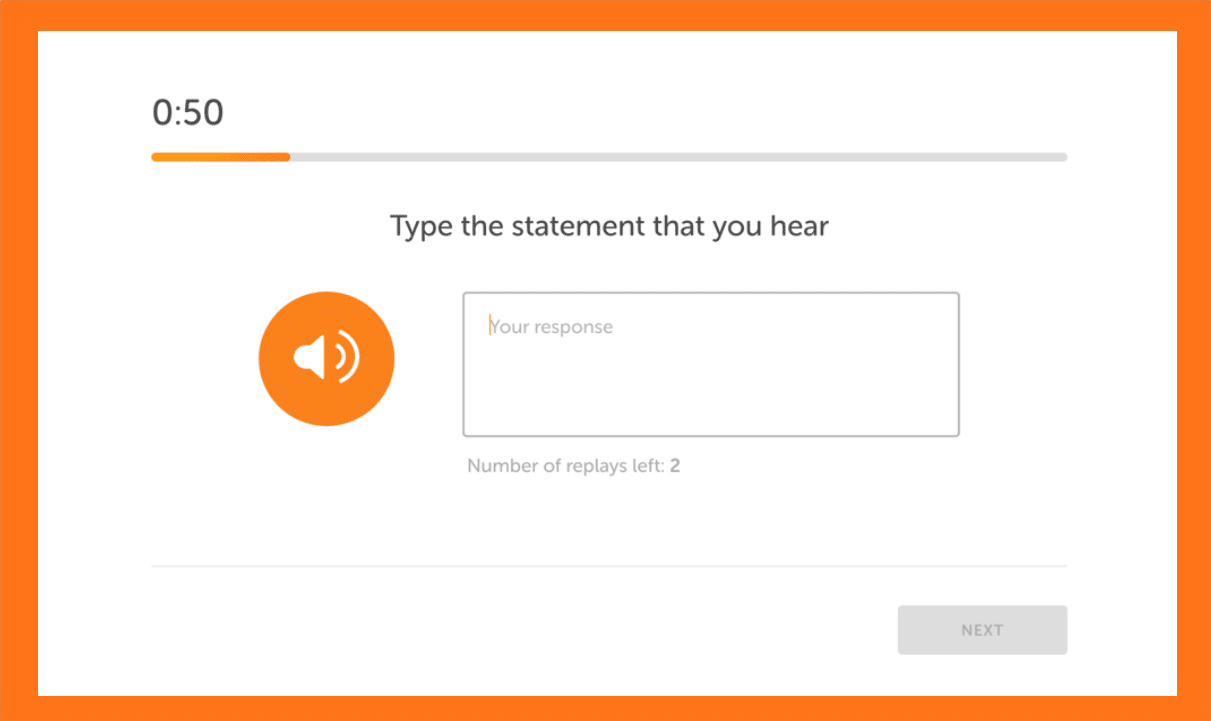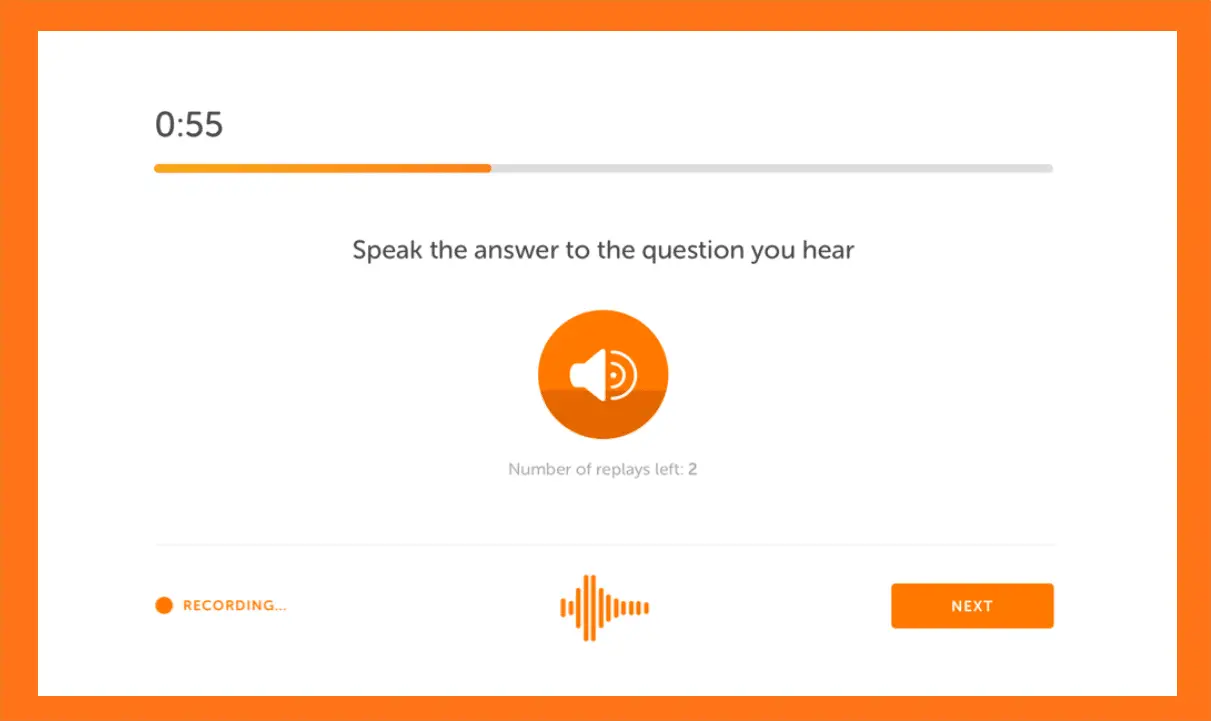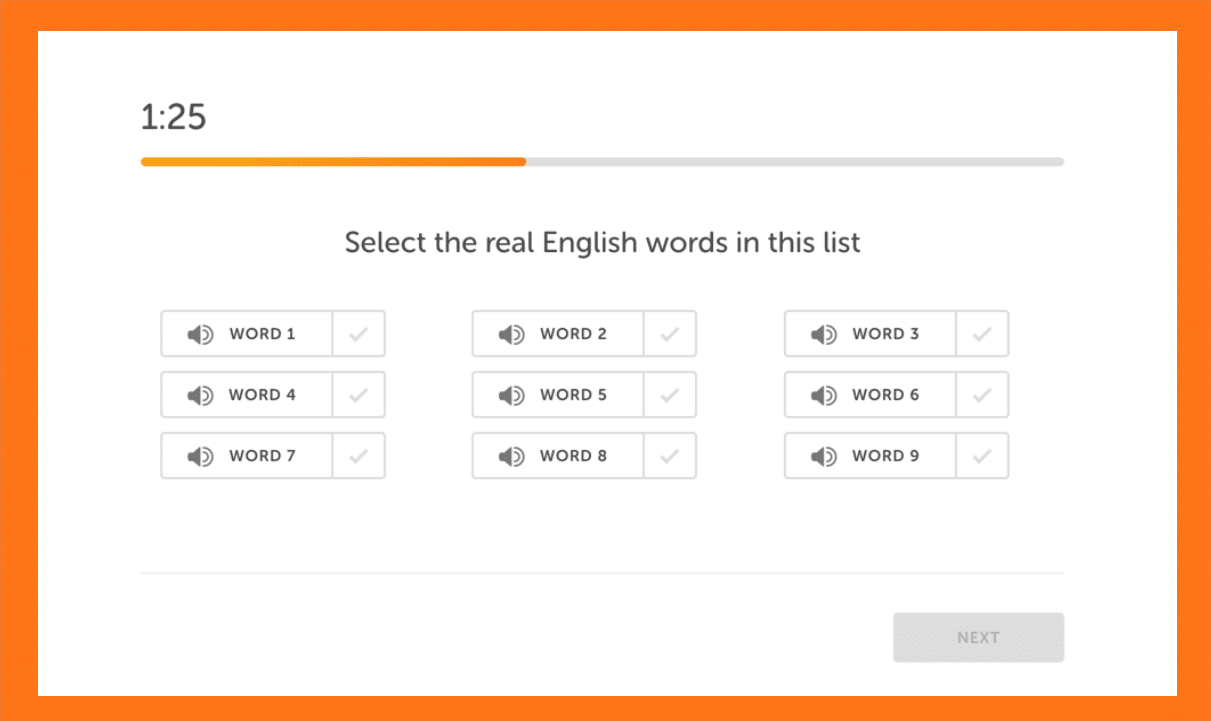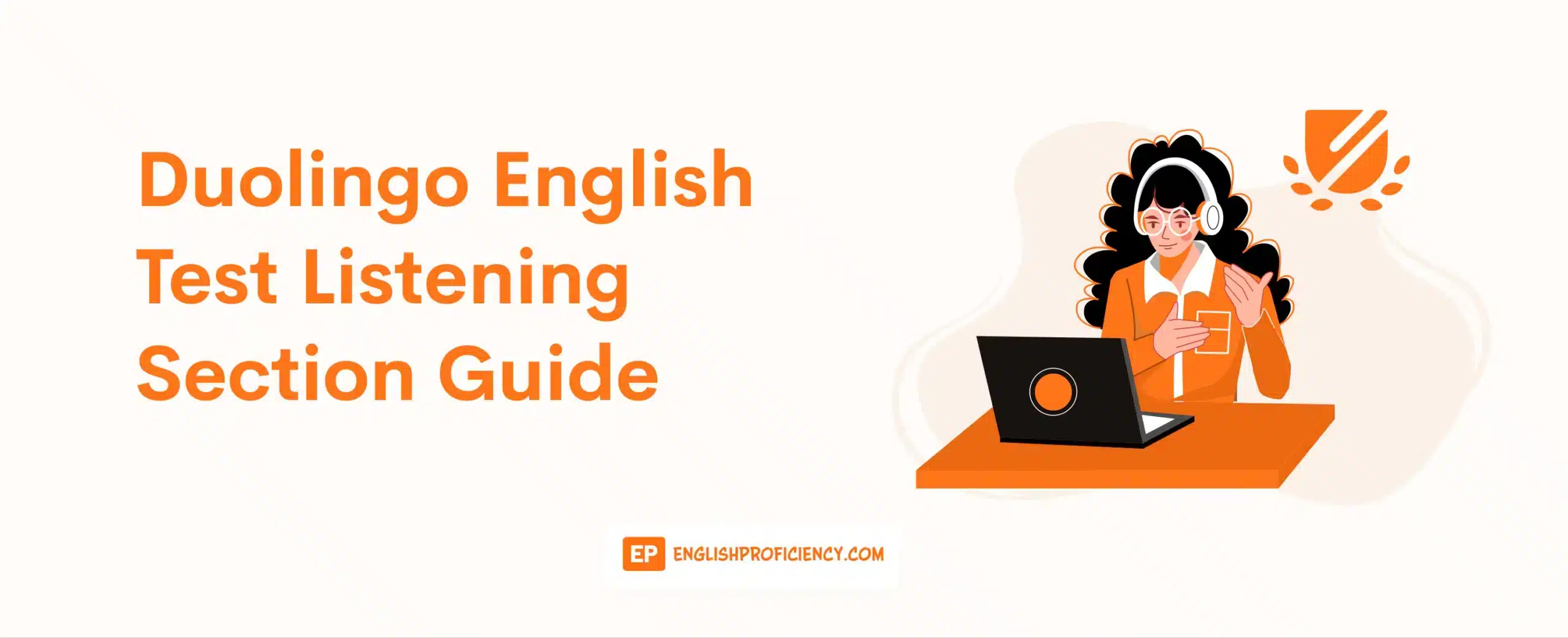Unlike TOEFL iBT or IELTS, the Duolingo English Test does not include a “listening section” due to its adaptive nature. However, it includes various question types that will assess your listening skills as well as reading, speaking, and writing.
We will discuss in this article the structure of the Duolingo English Test focused on the Listening Question Types and practice questions that will help you achieve high scores.
- What is the Duolingo English Test?
- What are the Production Scoring Criteria in the Duolingo English test?
- What are the Different Listening Question Types on the Duolingo English Test?
- Useful Tips to Prepare for Listening Question Types on the Duolingo English Test
- How to Improve your English Listening Skills?
- General Tips for Taking Duolingo English Test
- Duolingo English Test Practice Listening Questions
- Additional FAQs about the Duolingo English Test Listening Questions
What is the Duolingo English Test?
The Duolingo English Exam (DET) is a language competence test for students and institutions. The DET is designed for non-native English speakers as well as native English speakers.
The test’s difficulty level rises with each right response and falls if your answers are incorrect. Unlike previous English proficiency exams, applicants do not need to go to a test center to take the exam; they may take it at their leisure from the comfort of their own homes. The validity of the Duolingo English Test is two years.
What are the Production Scoring Criteria in the Duolingo English test?
Subscores may help institutions make more informed selections about candidates by identifying the skill profiles that are essential to them. If a school appreciates its candidates’ ability to communicate in study groups, they might set higher minimum Conversation admissions scores.
Subscores may help you identify their strengths and limitations, enabling them to better concentrate on future language studies.
- Overall Duolingo Score: The overall Duolingo score is based on a scale of 10 to 160. A brief description of your assessment is also included in the total Duolingo score. It’s worth noting that the total Duolingo English test results aren’t equal to the sum of the subscores. The total score’s primary purpose is to demonstrate your significant talents and qualities.
Subscores in Duolingo: The subscore’s purpose is to offer information about your performance based on particular abilities included in the Duolingo English exam pattern. It evaluates your ability to comprehend and analyze the English language in certain contexts.
There are four components to Duolingo subscores. Each Duolingo subscore is scored on a scale of 10 to 160.
- Literacy: This Duolingo subscore assesses your reading and writing skills.
- Conversation: This Duolingo subscore assesses your listening and speaking abilities.
- Comprehension: This Duolingo subscore assesses your listening and reading abilities.
- Production: This Duolingo subscore assesses your writing and speaking skills.
To give you a better understanding of Duolingo scores, here is a table that includes the ranges of both Duolingo overall scores as well as its subscores:
| Conversation | 10 to 160 |
| Literacy | 10 to 160 |
| Comprehension | 10 to 160 |
| Production | 10 to 160 |
| Overall | 10 to 160+ General Description |
What are the Different Listening Question Types on the Duolingo English Test?
The Duolingo English test is less than an hour-long, and below are the question types that will assess your listening skills:
Listen and Type
During this type of dictation, you will listen to a spoken sentence or short paragraph and then use the computer keyboard to type it out. You have a total of one minute to listen to and copy what they hear. You have the option of replaying the section three times.
This exam section measures your capacity to identify specific words and to retain them long enough in memory to duplicate them appropriately; both of these abilities are necessary for spoken language comprehension.
Additionally, dictation activities have been linked to language learner intelligibility in speech output.

Listen, Then Speak
This listening question type is part of the extended speaking task, which assesses your ability to communicate in English.
You will verbally respond to a spoken question, and you must talk about the question for at least 30 seconds. Because your responses will be recorded, make sure you answer all of the questions completely and clearly.

Listen and Select
This is a version of the “yes/no” vocabulary exam. You are provided with a collection of English words mixed with pseudo-words that are made to seem English-like and must be discerned between them.
Such assessments have been used to measure vocabulary knowledge at different CEFR levels. They have been proven to predict language competence skills—the audio version indicates listening and speaking abilities in particular.
These tests often present a large collection of stimuli (e.g., 60 words and 40 pseudo-words) of mixed complexity at once. The format is made computer-adaptive by repeatedly showing various sets (items/tests), each having a few stimuli of the same complexity.

Summary Table of the Duolingo English Test Listening Question Types
| Duolingo English Test Listening Question Type | Key Points |
|---|---|
| Listen and Type |
|
| Listen and Select |
|
| Listen, Then Speak |
|
Useful Tips to Prepare for Listening Question Types on the Duolingo English Test
Some of you probably wonder whether the Duolingo English Listening questions are difficult. The truth is that if you prepare appropriately, it is simple. Here are some useful tips to help you prepare for each listening question type:
Listen and Select
You will be given alternatives to pick from what they believe are real English words, but rather than reading the words, they will listen to an audio to identify the correct answer, similar to the Read and Select section.

Useful tips:
- Pay close attention to the individual syllables of each word; some fabricated words may vary drastically from the genuine article.
- Use only sentences that you are certain are correct.
- Before clicking the NEXT button, double-check the words you’ve chosen.
- Each sentence may be repeated indefinitely.
- To re-hear, the words, click the speaker icon next to them.
- Select an orange checkbox to indicate that you believe a phrase is a genuine English term ().
- Orange will be used to highlight your choices.
- If you change your mind, click the checkbox again to deselect a word.
Listen and Type
There will be an audio file with English phrases that you will have to listen to. They must then write down the phrase they were able to understand from the audio.

Useful Tips for the Listen and Type Section:
- To begin, jot down what you hear.
- Then, by repeating the text, compare your emotion to what you wrote.
- You may play the message up to two times by clicking on the orange speaker button (a total of three times).
Listen, Then Speak
You will be required to listen to the spoken prompt and speak out their response, similar to the question type above.
Before being immediately sent to the recording screen, candidates will have 20 seconds to listen to and repeat the question.

Useful Tips for Listen,Then Speak Section:
- Rather than merely labeling a picture, try to provide a detailed description.
- Even though the guidelines only allow for one, try to write more than one complete statement.
- While typing your comment, you will be able to view the picture.
- You may use your mouse or touchpad to scroll back into your remark if you need to double-check your spelling or grammar.
How to Improve your English Listening Skills?
Listening skills are a critical element of effective communication. When you are an attentive listener, you may begin to strengthen connections, make better-informed judgments, and reach agreements more quickly with others.
Additional reasons why listening skills are important include the following:
Practice listening to anything in English every day and progressively increase your listening duration.
- Take note of the many sorts of materials.
- Actively listen. Attempt to respond to the following questions: who, what, where, when, why, how
- Passively listen to obtain a sense of what is being stated.
- Maintain a listening journal (a record of everything you listen to in English on a daily/weekly basis).
- Create a one-sentence summary to help you recall the central concept of what you heard.
- Make a note of any new phrases, idioms, or terminology that you come across.
- Dictation and other listening activities may help you improve your listening capacity.
- Solicit the assistance of an English native speaker in dictating an article to you. Podcasts, journals, internet articles, and textbooks are all excellent material sources.
- Then, take notes on just the most salient facts you hear.
- Conduct knowledge gap activities using novel topics and intricate architecture.
Utilize community resources to practice listening to English
- Visit locations where you may develop your listening skills.
- Enroll in an English class if feasible.
- Visit a museum and take an English-language audio tour.
- Take an English-language guided tour of your city.
- Contact or visit a hotel where travelers stay to get English-language information about room pricing, hotel availability, and hotel amenities.
- Make an English-language call and listen to recorded information, such as a movie schedule, a weather report, or information on an airline trip.
- Watch or listen to English-language television shows and podcasts.
- CNN or Discovery Channel and soap operas or situation comedy are all beneficial television networks to listen to.
- Discuss the program with a friend.
- Watch movies or other videos online (without the subtitles!) or attend an English-language film.
- Listen to an English audiobook.
- Listen to recordings in the English language that includes a transcript. At a minimum, listen to each tape three times:
- Take notes the first time you hear anything.
- Read the transcript a second time and listen to the thoughts you recorded.
- The third time, jot down any unfamiliar terms or phrases and look them up.
- Communicate in English with others.
- Exchange language classes with an English speaker who wants to enhance their language skills.
Prepare for academic circumstances by beginning now.
- Visit English-language academic courses.
- Make a point of recording lectures or seminars and playing them back numerous times.
- Repeat brief portions multiple times until you grasp the fundamental concepts and the flow of ideas.
- Pause the recording in the middle and provide a prediction about what will happen next
- Acquaint yourself with the format or structure of academic lectures.
- Keep an eye out for the difference between the primary concepts and the specifics offered.
- Keep an ear out for the broad (central) concepts.
- Attend to details — facts, examples, and personal perspectives.
- Take note of the structure.
- Introduction, body, and conclusion of a lecture or presentation
- Beginning, middle, and conclusion of a narrative tale
- Recognize various organizational styles.
- Theorem and proof
- Relationship between cause and effect
- The stages of a process
- Contrast two items
- Consider the lecture’s goal carefully.
- Consider the following: “What is the lecturer attempting to achieve with this lecture?”
- Make a note of just the facts you hear. Take caution not to interpret material only on the basis of your own perception or expertise of the subject.
- Create a note-taking approach to assist you in organizing data into key points and supporting facts.
- Assemble your notes in accordance with the lecture’s arrangement.
- Keep an ear out for related concepts and linkages within a lecture, and ensure that comparable content is summarized together.
- Create a summary from your notes.
Listen for cues that will assist you in comprehending the order of a conversation, the links between ideas, and the significance of ideas.
- Pay close attention to the terms and terminology that indicate the sort of information being conveyed. Consider the sort of information conveyed by these phrases:
- opinion – I believe, it seems as if, it is believed that
- theory — in theory
- inference — then
- negatives — not, words beginning with “un-,” “non-,” “dis-,” or “a-” fillers — non-essential information — uh, eh, um.
- Recognize digressions – discussion of a subject unrelated to the primary subject — or irrelevant jokes to the main presentation. It is OK to be unable to comprehend them!
- To detect the link between concepts, listen for signal words or phrases that connect them. Consider the relationship between the concepts shown by these transition words: because, since, for example, such as, in contrast, on the other hand, etc.
General Tips for Taking Duolingo English Test
Reading, writing, speaking, and listening are measured in the Duolingo English Test.
Here are some Duolingo English test hints on Duolingo review if you’re thinking about taking the Duolingo English Test:
- Take your time.
As you complete each activity, a tab will appear that is continually ticking down to the task’s completion time. However, do not be intimidated.
The exam is intended to provide you with as much time as necessary to complete the work correctly – you will almost certainly complete the task sooner than anticipated.
Therefore, take your time with the assignment – do not get so focused on the time restriction that you overlook the right answers.
- Make time for planning.
Certain questions — for example, the writing questions – need you to pause for a moment before beginning.
Take a few seconds to inspect the picture in the ‘Describe a photo’ problem before you begin writing. Similarly, for the ‘Write a short paragraph’ challenge, repeat the procedure.
You may write more fluidly and with fewer erasures or mistakes when you have a framework in mind.
- Focus on your talking prompts.
You will be given a few prompts/points to cover for the speaking test. ‘Talk about a quick topic.‘ During your prep time, think about your topic for 30 seconds while scanning the recommendations.
When you begin responding, concentrate on each issue in turn and talk about your subject. By focusing on these aspects, you can maintain a natural flow of speech.
- Take note
This is critical for listening activities, notably the ‘Type recorded phrase’ challenge.
You will be provided with two replay choices, which will come in handy if you cannot recall any portion of the statement while completing the job.
However, pay close attention the first time the tape plays to ensure that you don’t miss out on the opportunity to replay if you truly need it.
Additionally, after you’ve completed the activity, if you have any remaining replay options, you may utilize them to double-check your response.
- Before submitting your work, ensure that it is error-free.
This one is necessary. In the event that there is still time on the clock, do not rush to hit ‘Submit‘ – rather, read over your work, looking for unintended spelling errors, missed punctuation, etc.
Taking the time to proofread your work might make all the difference in terms of obtaining high scores.
Duolingo English Test Practice Listening Questions
Listen and Type
Answers for ‘Listen and Type’ Question
Level 1
A. Is she reading a book? Yes, she is.
B. Does she work in this city?
C. My friend wrote another book.
Level 2
A. We have never spoken about work.
B. This task takes approximately 3 hours.
C. The company employs people throughout the world.
Level 3
A. Finally, the results of this investigation were published in a scientific magazine.
B. Even without seeing you, I would have recognized you by the sound of your voice.
C. They will have tried to talk to you by the time the story has been published.
Listen and Select
Answers for “Listen and Select” Questions
Level 1
| A | often (WORD 1) | paper (WORD 2) | world (WORD 3) | bath (WORD 4) | before (WORD 5) | and (WORD 8) |
| B | lost (WORD 2) | carpet (WORD 5) | again (WORD 7) | |||
| C | paper (WORD 1) | world (WORD 2) | winter (WORD 3) | before (WORD 4) | and (WORD 9) |
Level 2
| A | facility (WORD 3) | inspire (WORD 7) | parachute (WORD 8) | insurance (WORD 9) | |
| B | instructor (WORD 2) | refund (WORD 5) | optional (WORD 6) | chart (WORD 7) | shell (WORD 8) |
| C | economist (WORD 2) | bookmark (WORD 8) |
Level 3
| A | suspense (WORD 1) | portrait (WORD 5) | formula (WORD 6) | discriminate (WORD 7) | |
| B | pinpoint (WORD 5) | shutter (WORD 7) | retailer (WORD 8) | intellect (WORD 9) | |
| C | legislation (WORD 2) | vandalism (WORD 6) | massacre (WORD 7) | rally WORD 8) | solitary (WORD 9) |
Listen, Then Speak
Answers for “Listen, Then Speak” Question:
Because they are open-ended questions, there is no such thing as a “right” answer.
Additional FAQs about the Duolingo English Test Listening Questions
Can I Take Duolingo English Test Without a Passport?
Yes. You can use other forms of an identification card such as a driver’s license or a government photo to register for the Duolingo English Test.
Registration for the Duolingo English Test does not require a passport.
Can I Cheat in the Duolingo English Test?
The answer is no.
There were many security measures in place to guarantee that you would not cheat.
You must provide identification to the camera, you may not use headphones, you must be the only person in a well-lit room, and you must be visible on video at all times. It would be tough to have someone aiding you or assisting you in cheating.
Is the Duolingo English Test Monitored?
Yes. To pass the pre-exam checklist, you must have a computer with a functional microphone, speaker, and camera to take the examinations. As soon as the exam begins, you will be unable to look away from your screen or have anyone in the same room with you.
The Duolingo staff will check the recorded exam after the test to ensure you are not cheating.
What is the Maximum Number of Times We May Take the Duolingo Test?
In every 30-day period, you may take the Duolingo English exam twice.
There are no further restrictions on how many times you may take the exam. Exam results are valid for two years and maybe forwarded to as many institutions as you wish at no charge.
Is There Any Way to Get a Bad Score on a Duolingo Test?
Duolingo is set up so that the following question is through an adaptive system.
Negative points are assigned to the unanswered question. Unlike other English proficiency exams, the cost of taking it is relatively modest, at USD 49, with free reporting to any number of universities.
Additional Reading — Duolingo English Test Test Guide


